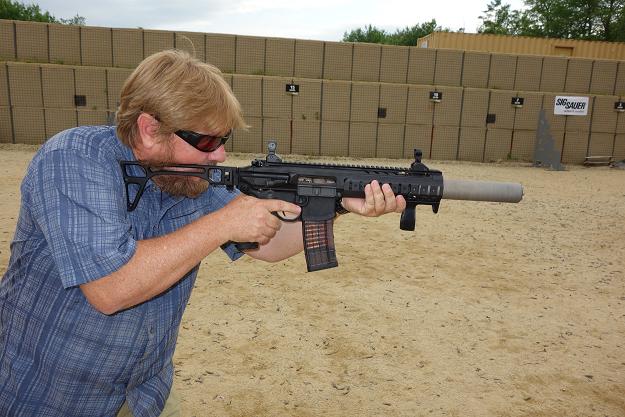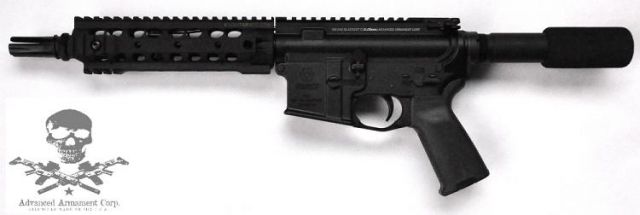
IPFS
.300 Blackout...The hottest new thing in AR15 stuff
Written by Chip Saunders Subject: Gun Rights( Publisher: If all I need is a new barrel... http://www.amazon.com/s/?ie=UTF8&keywords=300+blackout+barrel&tag=mh0b-20&index=aps&hvadid=4967301317&hvqmt=e&hvbmt=be&hvdev=c&ref=pd_sl_5ssjovbibg_e :)
Last night at the pool party I made mention to you about this "new" (actually about 7 years old now) cartridge that gets full rifle performance equaling the AK47 but out of a much shorter AR15 pistol envelope, which needs only a different barrel to convert.
I figured I'd put together a short tutorial here about it for you.
First, in order to research this cartridge on your own if you choose to, you need to know it has more than one name. The reason for this is that while it was developed by one company, who intended to be the exclusive supplier of everything about it and therefore trademarked the name,...other companies who saw the potential for the new round didn't want to pay licensing fees to make and sell their version of stuff for it. So, they just referred to the new round by a different name, somehow getting around the trademark restrictions in that way. Thus, while the original name for this round is the .300Whisper, .300AAC (Advanced Armament Corporation) is another name, and the most common name by which it is now known is the .300 Blackout.
The genesis for this new cartridge was the dilemma many special forces groups face when selecting a single universal weapon for all missions: You can have an EFFECTIVE rifle, or you can have a QUIET rifle, but it was not possible to have both in one package.
Experimentation showed that the old original 7.62x39 AK47 cartridge had potential to be loaded with extremely heavy bullets loaded to sub-sonic velocities, yet still have sufficient energy to cycle the rifle. This would in theory allow for regular light bullets common for the weapon to be used when sound is not a concern, yet use of the special sub-sonic ammo and a sound suppressor when silence was needed. However, such heavy projectiles were not commonly available to load up this ammo, and standard AK47 rifling in barrels of production weapons was of insufficient rate of twist to stabilize the longer projectiles in flight. (Longer bullets require a "faster" twist, shorter ones use less.) As a result, while the desired end result was possible,...entirely new production of several components would be required, raising cost of the proposed end product.
Shooters who experiment producing new cartridges from old designs (known in the community as Wildcats) had for years tried to figure out how to use the readily available surplus of .223 cases to produce something a bit more lethal than the parent case and its puny .22 caliber projectile. Wildcat cartridges of nearly every bullet diameter had been tried, producing examples with .25 caliber, 6mm, 6.5 and even .270 caliber case mouths. But no one ever bothered with .30 caliber, for reasons which are fairly esoteric and need not be detailed here.
Originally developed in the 80's by J.D. Jones, a very famous handgun hunter and maker of specialized single-shot pistols and suppressors, it was one of his Whisper line of cartridges. For years it was an obscure curiosity known to only the hardcore hobbiest gun guys like myself. However, the guys at AAC, who make suppressors as their sole business concern, including many government contracts,...had a different point of view of what "performance" is. And they saw that a .223 case with it's neck blown out to .30 caliber might be something useful for "quiet warriors" when used in the AR15 envelope.

The result of that experimentation bore fruit. But unlike the 7.62x39 cartridge for which a limited range of bullet weights and types were available, due to it's .311 diameter, the new .300AAC used regular "American" .308 diameter bullets, for which the widest range of options existed. And as it turned out, most importantly, it used a case base diameter that allowed rather easy modification of any existing weapon chambered for .223, requiring in most cases only a barrel change. It even used existing magazines for the parent .223 cartridge.

But for those who carry silenced weapons into dangerous places far overseas, the new cartridge also had another unique feature. The ratio of the internal dimensions of the case relative to the case mouth allowed for a more complete burning of propellant in a much shorter barrel. That is to say;...while the .223 cartridge attains complete burn of it's propellant and a resultant best maximum velocity with 20 inches of barrel, and the 7.62x39 does the same with a 16 inch barrel,...the .300AAC/Blackout reaches full burn and velocity with only 9 inches of barrel!! (The science behind why is a dry and droll dissertation on propellant pressure curves and pressurized volumetrics, so we won't go into that.) Meaning that you can hang a 7in. suppressor on the end of that 9in. barrel and have a weapon no longer than a standard 16in. carbine, but be quiet about it. The significance of that benefit cannot be over-stated.

So the special forces community is reported to have enthusiastically embraced this new cartridge. Although no one in position of authority to confirm will do so, it is reported that Delta Force and the Navy Seals were among the first early adopters. In fact, rumor has it that the Seal team which killed Bin Laden was armed with these suppressed .300Blackout carbines. And the makers of the movie ZERO DARK THIRTY portrayed that in the final battle sequence.
AR15 pistols are not new and have been around for over 20 years. But they were primarily regarded as merely nothing but noisy toys, not useful in any serious way in actual combat. The reason, as alluded to earlier, is that the .223 cartridge is dependent upon velocity for it's terminal performance on people, and so much velocity is lost with a short barrel that wounds from such weapons were unimpressive.
But the advent of the .300AAC/Blackout has single-handedly reinvigorated the interest in AR15 pistols and short-barrelled rifles (also called SBRs). Much of the commercial civilian components and variations of these are leftover developments resulting from many companies trying to entice government adoption of their latest whizbang for the new round.

But then, driving interest in these to even higher levels, was the development and BATF's approval of the "arm brace", wherein attachments that allow one to brace these rather heavy handguns using one's forearm (but also serve well to mimic a short butt stock) are currently considered legal accessories. While one is not supposed to use the arm brace as a butt stock, nearly everyone does. The result is that one can enjoy the benefits of an SBR without having to pay a $200 tax, get fingerprinted and wait half a year for approval.


BATF has issued directives stating that anyone observed misusing an arm brace from the shoulder is able to be prosecuted for violation of some sort of crime. But as of yet, there has been no one yet arrested for the test case. Just be careful who sees you enjoying your little friend.
Because the round is new, ammo for it is more expensive than the readily available .223 or 7.62x39. Cost is closer to that for larger "battle rifle" cartridges like .308 or .30-06. But as adoption becomes more wide spread, cost continues to slowly drop.
By comparison, .223 ammo can currently be had for as little as $0.32 cents per round for blasting, and $0.88 cents for more effective "go-to-war" ammo. 7.62x39 costs about $0.25 cents per round for cheap stuff, and $0.58 cents for the effective stuff. .300AAC/Blackout, on the other hand, at it's cheapest sells for about $0.60 cents a round, but even the special heavy bullet sub-sonic ammo is not that much more, at only about $0.85 cents per round. And of course, if one reloads their spent brass, prices are even cheaper.


 Feature Article • Global
Feature Article • Global
Things needed to convert to .300AAC/Blackout
So here is a short list of what you need to change your rifle over to .300Blackout, as well as a list of what further you need if you wish to build a whole other upper assembly to simply swap off and on between calibers.























